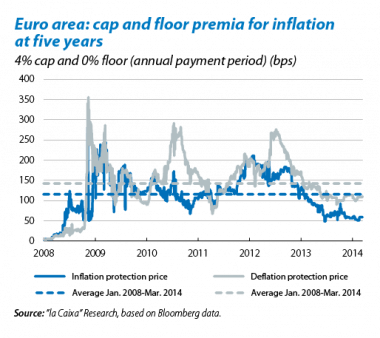Inflation expectations and financial instruments: a valuable duo
Fears of a possible deflationary episode in the euro area are bringing to the fore a variable that usually remains in the background: inflation expectations. In fact, it is crucial to know the range of price scenarios being considered by economic agents in order to gauge the risk of inflation or deflation and hence the right monetary policy strategy. Although direct observation of «real» inflation expectations in the private sector is not possible, reasonable estimates are offered by various financial instruments, either explicitly or implicitly.
The sovereign bond market provides very useful information when there are inflation-indexed bonds as well as ordinary nominal bonds. This is the case of key countries such as Germany and France. Indexed bonds offer protection against inflation by revising their face value at the same rate as the increase in each country's official price index. In this way, the spread in yields between a nominal and indexed bond with the same term and by the same issuer, called the breakeven inflation rate (BEIR), informs us of the average inflation rate expected by bond holders for this term. More accurately, the BEIR can be broken down into three different elements: (i) agents' expectations regarding the average inflation rate during the term of the pair of bonds; (ii) a risk premium associated with possible deviations from these expectations compared with the actual rate of inflation that will eventually occur, and (iii) premia associated with the lower liquidity of indexed bonds and other institutional aspects. Using statistical techniques to eliminate this last component, we are left with a very valuable measure of the expectations and risk premia for inflation of the large group of agents that take part in the bond market.
Swaps and options (caps and floors) on inflation are instruments explicitly designed to operate on this variable. A swap is an agreement between two parties to exchange interest rate cash flows based on a specified notional amount on concrete dates. The particular feature of inflation swaps is that one of the parties undertakes to pay a fixed interest rate (swap rate) on the notional amount of the contract in exchange for receiving the inflation rate observed during the instrument's term (floating swap rate). In this way, the swap rate is a good indicator of the expected average inflation rate and of the risk premium for deviation required by operators in this market throughout the life of the swap. Here it is also necessary to make a small technical adjustment, in this case for the counterparty risk inherent in the operation with over-the-counter (OTC) derivatives. The advantage of swaps compared with bonds is the existence of a larger universe of maturities and countries (including Spain) while the disadvantage is that this is a smaller and less liquid market.
Inflation caps and floors also offer protection against the adverse effects of inflation and deflation, respectively. In the case of caps, the buyer will receive, on each settlement date and after paying a premium on the notional amount, the difference between actual inflation rate and the ceiling or cap rate established in the contract, should this be higher. Floor options cover their buyers against a possible deflationary situation, paying them the difference between the agreed minimum or floor rate and the actual inflation rate, should this be lower. The price or premium for these options will tend
to be higher the greater the degree of protection being offered. The last few months have seen the five-year floor price, which protects should inflation fall below 0%, go above the cap price of 4% over the same horizon. In terms of the ECB's inflation target of 2%, this suggests that investors are more concerned about actual inflation being lower rather than higher, not surprising given the current context. What is surprising is that, unlike in the three previous «deflationary scares» of the last few years, the floor premium has not shot up. This indicator therefore seems to support the interpretation that agents expect a long period of very low inflation for the euro area (clearly below 2%) but a low risk of sustained deflation.
